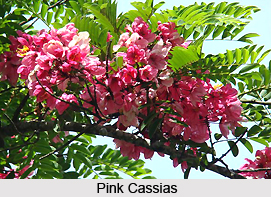 Carrying a Greek name for the genus of leguminous plants, the `Pink Cassia` provides the senna leaves and pods that are very much important in pharmacy. All the scientists of the world know the beautiful tree having some attractive pink; green and white cool shades, as `Cassia Grandis`. This tree derived from the family of `Leguminosae` and the sub family is `Caesalpineae`. In Tamil, the tree is called as `Pu Vakai` and in Malay, it is known as `Konna` .
Carrying a Greek name for the genus of leguminous plants, the `Pink Cassia` provides the senna leaves and pods that are very much important in pharmacy. All the scientists of the world know the beautiful tree having some attractive pink; green and white cool shades, as `Cassia Grandis`. This tree derived from the family of `Leguminosae` and the sub family is `Caesalpineae`. In Tamil, the tree is called as `Pu Vakai` and in Malay, it is known as `Konna` .
The `Pink Cassias` trees have a slight difference with the colourful shades of India`s other flowering trees that flowers in the Spring. Everyone admires the brilliance of `Cassia`, as the long and extensive branches of the tree stay laden with flowers when it is in full bloom. The `Cassia` has five different varieties. Each of them has their respective beauty that is almost beyond words. A few species of the `Pink Cassias` are originated in India. Though there are some doubts and controversies about the native places of the `Cassias`, they are nowadays very much common in gardens and roadsides in India.
The `Horse Cassias` normally grow up to the height of 15 m. In the cold season, all the leaves of the tree fall down and in the month of February and March, the old and matured leaves grow some fine sprays of rose-pink flowers. These flowers shade to pale peach and coral provided the amount of sunlight they receive. From the both sides of the main stem, the flower branchlets bounce with difficulty and give the softly relaxed sprays of the other Cassias, quite a different appearance. The flower stalks do not bear any bracts at the bases as they fall down before the flowers open. The leaves are about 3.8 cm. in length and bear near about fourteen to forty narrow oval leaflets, which are rounded at the ends. In the young age, the leaves are soft and feathery and the leaflets of the end posses a unique wash of bronze. The fruit of the tree is a fatty and curvy harsh pod that is usually 22 to 30 cm long. It contains the oblique seeds in a pulp that smells unpleasantly.



















